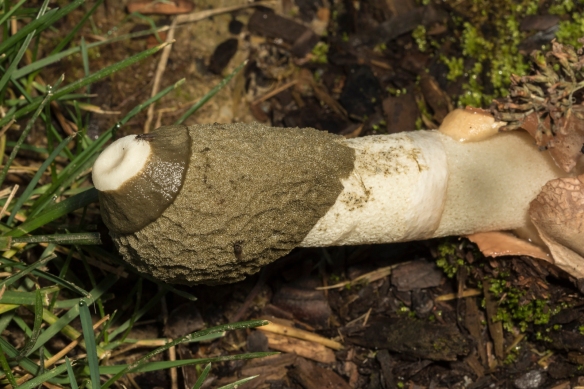..And you, whose pastime is to make midnight mushrooms…
~William Shakespeare’s The Tempest
I debated posting this one, for obvious reasons, but, it is just too weird not to post. Over the holidays, I was asked about a strange-looking mushroom growing in the mulch alongside a home. The description left no doubt in my mind – one of the stinkhorn fungi.
Stinkhorns are an amazing and strange group of fungi, most are in the family, Phallaceae (again, for obvious reasons). Although there are several genera representing a wide range of strange shapes, they all share some common traits: the fruiting body (mushroom) arises from a globular “egg” that can often be seen protruding from the ground at the base of the mushroom; and, unlike most fungi that rely on wind to disperse their spores, members of this family produce a foul-smelling slime which attracts insects that help disperse the spores (note the small fly on the top edge of the white tip) in the first photo.
Anytime one of these weird fungi pops up in someone’s yard, they inevitably create a lot of curiosity and reaction in the homeowner. A publication by Clemson Cooperative Extension perhaps summarizes it best...Mycologists (scientists who study fungi) often describe stinkhorns with adjectives such as amazing, interesting or unique. However, homeowners lucky enough to have these aromatic mushrooms suddenly appear in the yard just before an outdoor party will often describe them as disgusting, shocking, foul-smelling or simply gross. To make things worse (in terms of appreciating these unusual life forms), the slime that is produced to attract insects often smells like dog poop or a rotting carcass. Not very pleasing to us, but apparently very effective in attracting a host of flies, beetles, and other insects that typically come to clean up the nasties in our environment.
Looking at various online mycology resources, I think this one may be Phallus ravenelii, the Common Stinkhorn, or Ravenel’s Stinkhorn. This species tends to have a smooth or slightly rough texture on the cap compared to some other species with deeply pitted caps. They all are saprophytes, feeding on decaying organic matter, especially wood (hence their fondness for mulch piles). This species is found in the eastern United States and and the fruiting body usually occurs from late summer into autumn.
Another common stinkhorn variety I have photographed in the past is the Elegant, or Dog Stinkhorn, Mutinus elegans (or caninus ). It has another strange shape that might cause an embarrassed chuckle in an observer. But, stinkhorns have evoked a lot of other emotions in the past. I read that Darwin’s daughter had a particular hatred of certain stinkhorns. According to a Cornell blog about this story, she had such a disdain for them that she would go out on forays into the woods, looking and sniffing, until she found one. She then would poke the offending fungus with a pointed stick and put it into a basket she carried for the purpose. At the end of the day, the catch was brought back and burnt in the deepest secrecy on the drawing room fire with the door locked because of the morals of the maids.
Well now….I (somewhat shamefully) admit that when I am hiking along a woodland trail and catch a whiff of that smell, I look around with excitement to see which one of these strange mushrooms might be lurking nearby. They are always an amazing discovery. So, if you should find yourself in the company of one these bizarre fungi, stop and take a closer look, and marvel at nature’s strangeness and adaptability (just don’t let the neighbors see you).





Thank you. Very interesting! Tad Einloth
Thanks, Tad.